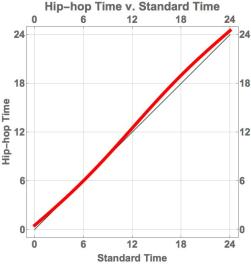At 2:00 AM on Sunday 28 October the clocks throughout Europe will be set back one hour, reverting to Standard Time. In many countries, the clocks are put forward one hour in Spring and set back to Standard Time in the Autumn. Daylight saving time gives brighter evenings in Summer.

In Summer, the mornings are already bright before most of us wake up but, in Winter, the mornings would be too dark unless we reverted to Standard Time.
Is there a way to get the benefits of “Summer Time” without the disadvantages? Yes, and the solution is remarkably simple. We could have Standard Time during the nights and morning, and Summer Time in the afternoons and evenings. This would provide brighter summer evenings, while avoiding the darker winter mornings. Welcome Hip-hop Time!
How would it operate. The answer is simple: we keep to Standard Time between midnight and noon, advance the clock one hour at noon each day and move it back an hour to midnight every night at 1:00 AM. This procedure applies throughout the year without variation.
Advantages of Hip-hop Time
To keep things simple, let us suppose that Standard Time corresponds to local solar time: the Sun is highest at noon Standard Time. Now suppose the typical summer sunrise and sunset times are 4:00 AM and 8:00 PM. With the new scheme, these become 4:00 AM and 9:00 PM: we get the benefit of a brighter evening. If winter sunrise and sunset times are 8:00 AM and 4:00 PM standard time, they become 8:00 AM and 5:00 PM. Again, we get brighter evenings.
There are other benefits. Assuming that the typical working day is from 9:00 AM to 5:00 PM, an eight-hour day. We could legislate that working time must be calculated as the difference in clock time between the start and end of the day. We would be paid for an eight-hour day but only have to work for seven. If we retire at 11:00 PM and rise at 07:00 AM we actually have nine hours of sleep even if the “legal” duration is the eight hour difference between clock times. Brilliant!
An Enhancement
With modern technology, the twice-daily clock changes of Hip-hop Time can all be done automatically: computer software can control the process which, in management yuck-speak, is “transparent”.
Current daylight saving times can have a disruptive effect on commerce and travel. To avoid the sudden jumps of one hour, we could simply vary the clock-rate smoothly over the day, running slower from midnight to midday and faster from midday to midnight but with 24 clock hours each day. A graph of Smooth Hip-hop Time H against Standard Time S, given by
jumps of one hour, we could simply vary the clock-rate smoothly over the day, running slower from midnight to midday and faster from midday to midnight but with 24 clock hours each day. A graph of Smooth Hip-hop Time H against Standard Time S, given by
H = S + ( 1 – sin (2π S / 24 ) ) / 2
is shown in the Figure.
Take it Easy
One of the purposes of Daylight Saving Time is to reduce energy consumption for heating and lighting. Hip-hop Time would have even greater advantages in this regard, as we would work one hour less each day and sleep one hour more each night. It’s a no-brainer, so let’s save the planet.
I cannot see any problems. Can you?
Note: The subtitle above is taken from a satirical essay published anonymously by Jonathan Swift in 1729 ( Wikipedia: “A Modest Proposal” )
